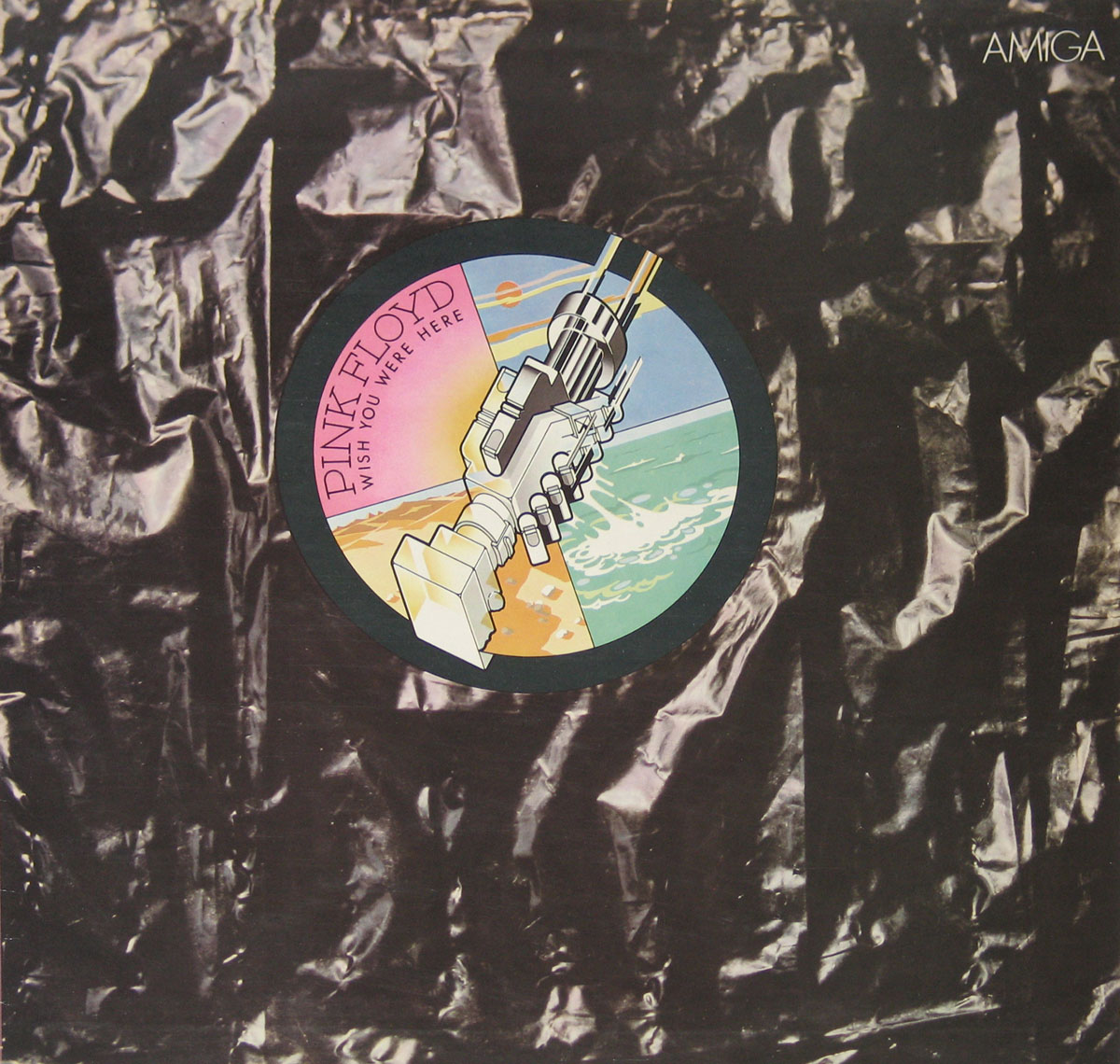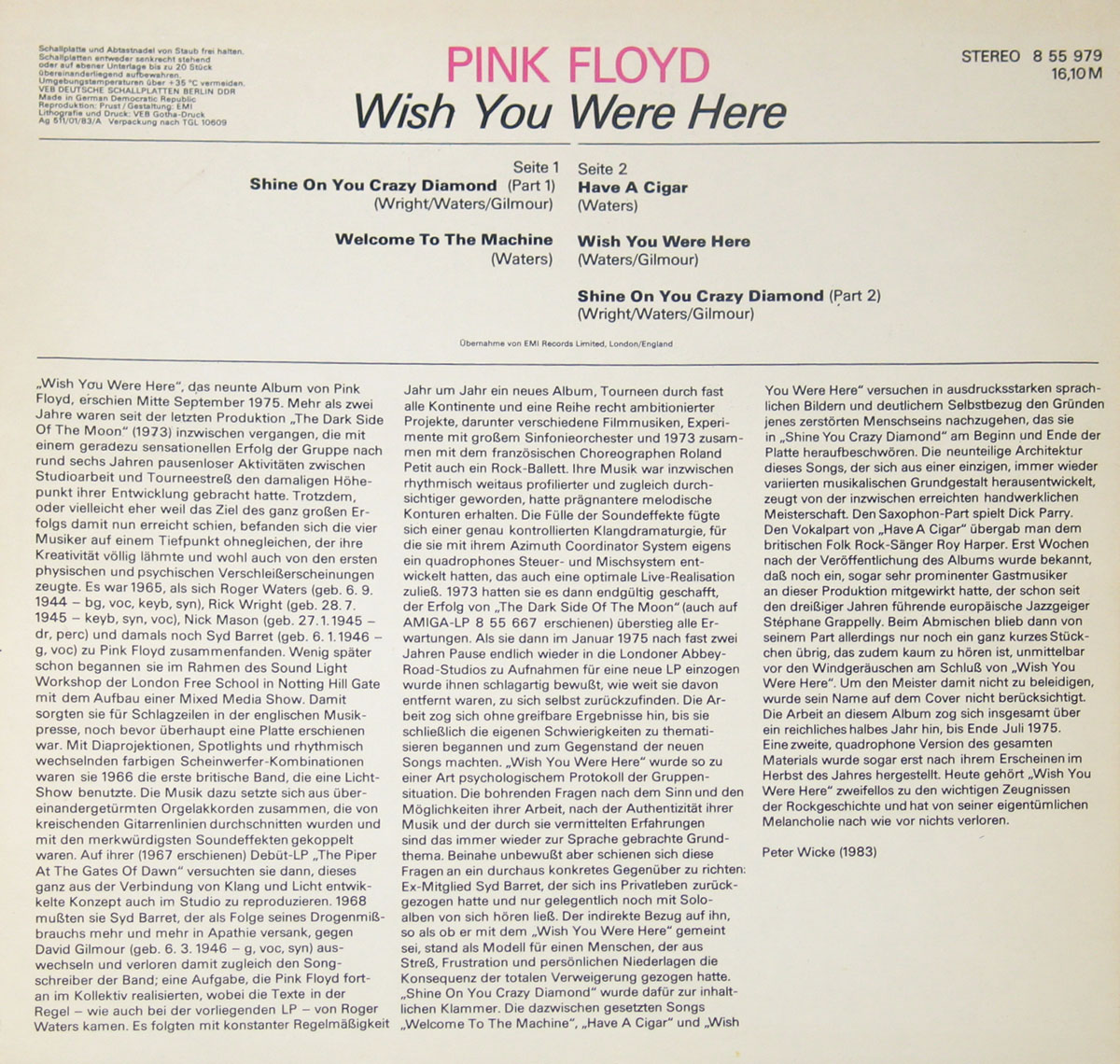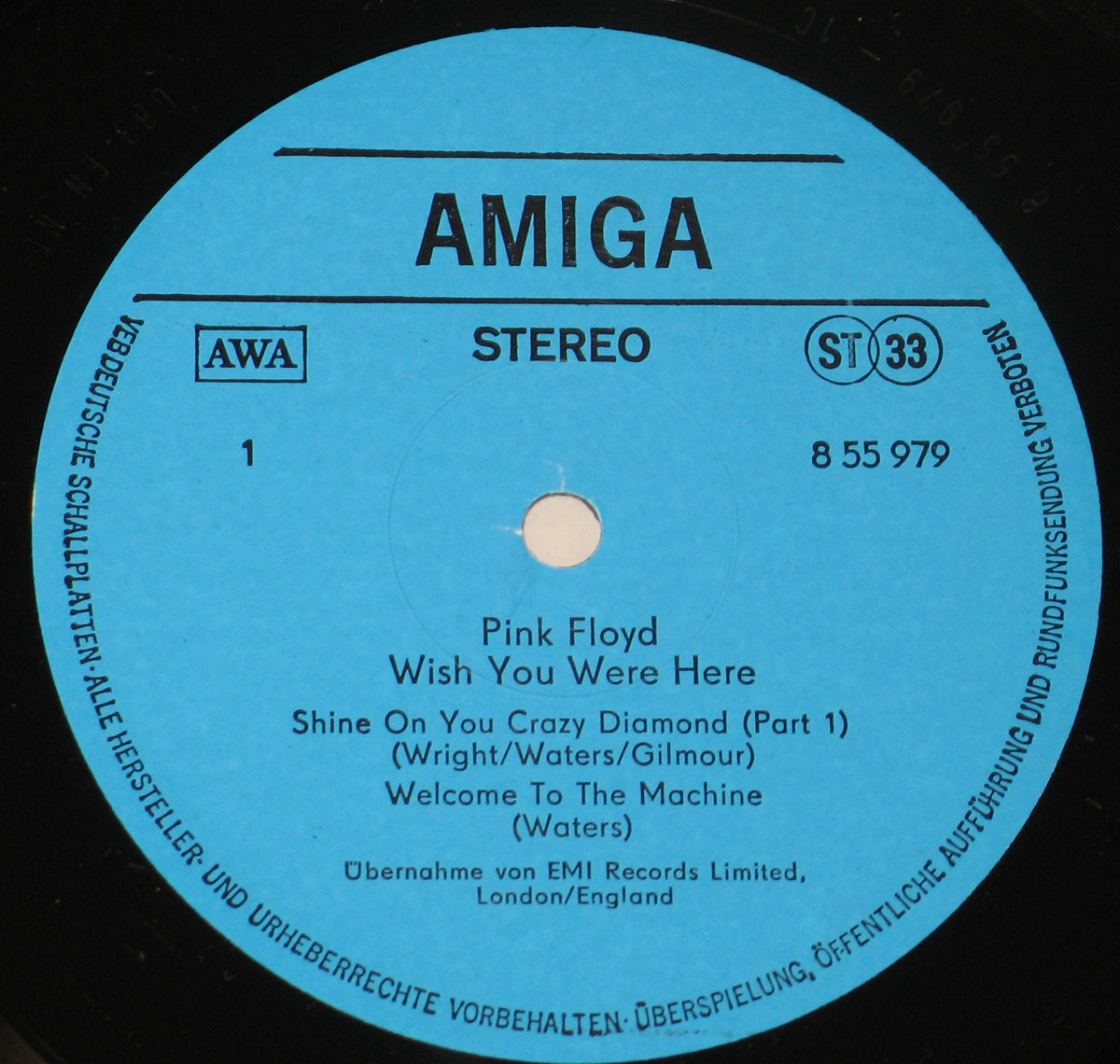„Wish You Were Here”, das neunte Album von Pink Floyd, erschien Mitte September 1975. Mehr als zwei Jahre waren seit der letzten Produktion "The Dark Side Of The Moon" (1973) inzwischen vergangen, the mit einem geradezu sensationellen Erfolg der Gruppe nach rund sechs Jahren pausenloser Aktivitaten zwischen Studioarbeit und TourneestreR den damaligen Hohe-punkt ihrer Entwicklung gebracht hatte.
Trotzdem, oder vielleicht eher weil das Ziel des ganz groRen Erfolgs damit nun erreicht schien, befanden sich the vier Musiker auf einem Tiefpunkt ohnegleichen, der ihre Kreativitat vollig lahmte und wohl auch von den ersten physischen und psychischen VerschleiRerscheinungen zeugte. Es war 1965, als sich Roger Waters (geb. 6. 9. 1944 - bg, voc, keyb, syn), Rick Wright (geb. 28.7. 1945 - keyb, syn, voc), Nick Mason (geb. 27.1.1945 - dr, perc) und damals noch Syd Barret (geb. 6.1.1946 -g, voc) zu Pink Floyd zusammenfanden.
Wenig spater schon begannen sie im Rahmen des Sound Light Workshop der London Free School in Notting Hill Gate mit dem Aufbau einer Mixed Media Show. Damit sorgten sie fur Schlagzeilen in der englischen Musik-presse, noch bevor Oberhaupt eine Platte erschienen war.
Mit Diaprojektionen, Spotlights und rhythmisch wechselnden farbigen Scheinwerfer-Kombinationen waren sie 1966 die erste britische Band, die eine Licht-Show benutzte. Die Musik dazu setzte sich aus Ober-einandergeturmten Orgelakkorden zusammen, die von kreischenden Gitarrenlinien durchschnitten wurden und mit den merkwOrdigsten Soundeffekten gekoppelt waren.
Auf ihrer (1967 erschienen) Debut-LP The Piper At The Gates Of Dawn" versuchten sie dann, dieses ganz aus der Verbindung von Klang und Licht entwikkelte Konzept auch im Studio zu reproduzieren. 1968 mussten sie Syd Barret, der als Folge seines Drogenmiss-brauchs mehr und mehr in Apathie versank, gegen David Gilmour (geb. 6. 3.1946 - g, voc, syn) auswechseln und verloren damit zugleich den Song-schreiber der Band; eine Aufgabe, die Pink Floyd fortan im Kollektiv realisierten, wobei die Texte in der Regel - wie auch bei der vorliegenden LP - von Roger Waters kamen.
Es folgten mit konstanter Regelmalligkeit
Jahr um Jahr ein neues Album, Tourneen durch fast alle Kontinente und eine Reihe recht ambitionierter Projekte, darunter verschiedene Filrnmusiken, Experimente mit grossem Sinfonieorchester und 1973 zusammen mit dem franzosischen Choreographen Roland Petit auch ein Rock-Ballett. lhre Musik war inzwischen rhythmisch weitaus profilierter und zugleich durch-sichtiger geworden, hatte pragnantere melodische Konturen erhalten.
Die ssine der Soundeffekte fugte sich einer genau kontrollierten Klangdramaturgie, fur die sie mit ihrem Azimuth Coordinator System eigens ein quadrophones Steuer- und Mischsystem entwickelt hatten, das auch eine optimale Live-Realisation zuliess. 1973 hatten sie es dann endgultig geschafft, der Erfolg von The Dark Side Of The Moon" (auch auf AMIGA-LP 8 55 667 erschienen) uberstieg alle Erwartungen.
Als sie dann im Januar 1975 each fast zwei Jahren Pause endlich wieder in die Londoner Abbey-Road-Studios zu Aufnahrnen fur eine neue LP einzogen wurde ihnen schlagartig bewugt, wie weit sie davon entfernt waren, zu sich selbst zuruckzufinden. Die Arbeit zog sich ohne greifbare Ergebnisse hin, bis sie schlieslich die eigenen Schwierigkeiten zu thematisieren begannen und zum Gegenstand der neuen Songs machten.
„Wish You Were Here" wurde so zu einer Art psychologischem Protokoll der Gruppen-situation. Die bohrenden Fragen each dem Sinn und den Mtiglichkeiten ihrer Arbeit, auch der Authentizitat ihrer Musik und der durch sie vermittelten Erfahrungen sind das immer wieder zur Sprache gebrachte Grund-thema. Beinahe unbewusst aber schienen sich diese Fragen an ein durchaus konkretes Gegenuber zu richten.
Ex-Mitglied Syd Barret, der sich ins Privatleben zurUck-gezogen hatte und nur gelegentlich noch mit Solo-alben von sich hoeren liess. Der indirekte Bezug auf ihn, so als ob er mit dem „Wish You Were Here" gemeint sei, stand als Modell fur einen Menschen, der aus Stres, Frustration und perstinlichen Niederlagen die Konsequenz der totalen Verweigerung gezogen hatte. „Shine On You Crazy Diamond" wurde dafOr zur inhalt-lichen Klammer.
Die dazwischen gesetzten Songs „Welcome To The Machine", Have A Cigar" und „Wish You Were Here" versuchen in ausdrucksstarken sprach-lichen Bildern und deutlichem Selbstbezug den Grunden jenes zerstorten Menschseins nachzugehen, das sie in „Shine You Crazy Diamond" am Beginn und Ende der Platte heraufbeschworen.
Die neunteilige Architektur dieses Songs, der sich aus einer einzigen, immer wieder varierten musikalischen Grundgestalt herausentwickelt, zeugt von der inzwischen erreichten handwerklichen Meisterschaft. Den Saxophon-Part spielt Dick Parry. Den Vokalpart von "Have A Cigar" Obergab man dem britischen Folk Rock-Sanger Roy Harper. Erst Wochen each der Veroffentlichung des Albums wurde bekannt, das noch ein, sogar sehr prominenter Gastmusiker an dieser Produktion mitgewirkt hatte, der schon seit den dreigiger Jahren fiihrende europaische Jazzgeiger Stephane Grappelly.
Beim Abmischen blieb dann von seinem Part allerdings nur noch ein ganz kurzes Stuck-chen Obrig, das zudem kaum zu horen ist, unmittelbar vor den Windgerauschen am Schlug von „Wish You Were Here". Um den Meister damit nicht zu beleidigen, wurde sein Name auf dem Cover nicht berucksichtigt. Die Arbeit an diesem Album zog sich insgesamt Ober ein reichliches halbes Jahr hin, bis Ende Juli 1975. Eine zweite, quadrophone Version des gesamten Materials wurde sogar erst each ihrem Erscheinen im Herbst des Jahres hergestellt.
Heute gehort „Wish You Were Here" zweifellos zu den wichtigen Zeugnissen der Rockgeschichte und hat von seiner eigent0mlichen Melancholic each wie vor nichts verloren.
Peter Wicke (1983)



 album front cover mediumsize.jpg)
 album front cover mediumsize.jpg)
 album front cover mediumsize.jpg)
 album front cover mediumsize.jpg)
 album front cover mediumsize.jpg)
 album front cover mediumsize.jpg)
 album front cover mediumsize.jpg)
 album front cover mediumsize.jpg)
 album front cover mediumsize.jpg)
 album front cover mediumsize.jpg)
 album front cover mediumsize.jpg)